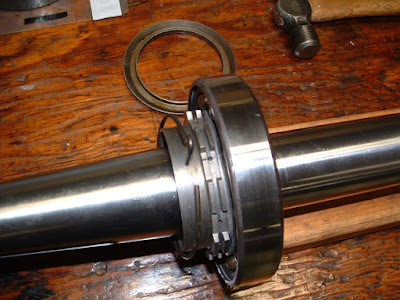Small bits of progress were made the past couple of weeks. First, the cockpit area:
 |
| Front seat |
 |
| Side panels |
I had to make the aluminum pieces that are also on the top longerons. These will go on last, after the fuselage is covered. The leatherette material on the inside will tuck under these. The upper fuselage sheet metal will cover the outside and hold them in place.
 |
| Inside of rear cockpit opening sheet metal |
Here the interior sheet metal is finally fitted up and temporarily installed. Andy had these parts made back in the '60's when he first bought the project. They were made by a United Airlines mechanic - back when the airlines had craftsmen and not just parts changers. Andy was a UA captain until his retirement in the mid '80's. Andy didn't get much farther on the restoration. The airplane sat in his shed until I acquired it in 2011.
These are some pictures of the crudely painted original pieces. I'm happy to have these as they will allow for good paint matching.
 |
| Original side panels |
 |
| Again, with beautiful brushed finish! |
On the OX-5, I wanted to have the cylinders on by this next post, but realized I had to finish up a few things first. I didn't leak-check the cylinders after installing the valves. I like to do it with stoddard solvent. Just invert the cylinder, pour in about a cup, let it sit for a few minutes and check for leaks around the valves. I had to touch up a few with lapping compound, but otherwise they came out fine.
 |
| Cylinder base gaskets |
Picked up some new cylinder base gaskets at Napa. Ha - well actually some gasket paper. I had a piece of an original gasket, made a template from aluminum, and then cut new ones from .015" gasket paper - the same thickness as the originals.
 |
| Gapping piston rings |
The rings also had to be gapped. Original specs call for .006" on the top ring and .004" on the second. Not much, but the stock rings are about .275" thick. I assume the gaps were this tight since thermal expansion would not be much of an issue with rings this thick, and with only 2 rings, blow-by would be a concern.
With the new pistons I had made and a conventional 3-ring automotive set-up, the gaps would have to be larger. I used typical .004" per inch of bore for the top ring (.016"), .005" per inch of bore for the second compression ring (.020"), and .015" for the oil ring rails.
So now, I am ready to install the cylinders - that will be next. I also may start fitting/installing the radiator. It has an interesting story that I'll mention in a future post. Talk to ya'll later!

































